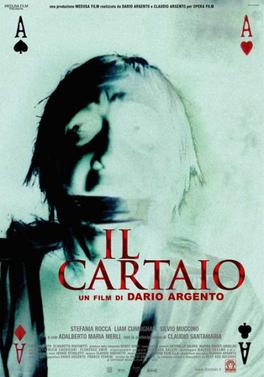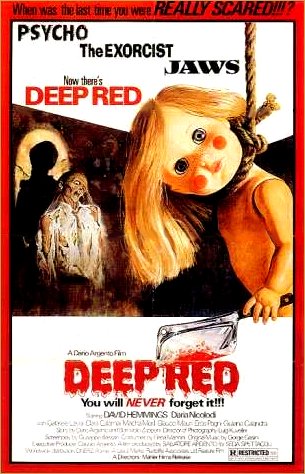DARIO ARGENTO - A BEGINNERS GUIDE
There are many words that you could use to describe Dario Argento, gifted, visionary, macabre, pioneering, handsome (probably not that one to be fair), but I'm not sure a word even exists in our language that describes just how great the man can be. He even opened a shop in Rome that's dedicated to how awesome he is. Not even Tarantino has done that (yet).
Whilst there a lot of horror fans who happily worship at the altar of the "master of Giallo" (Italian for yellow, as this was the colour of the cheap paperbacks that inspired the early thrillers, thus becoming a trademark word for lurid Italian slasher thrillers), he is criminally neglected amongst the mainstream horror fans, and frankly, this is a disgrace. So, because of that, I felt that I'd write up a little beginners guide to the work of the Italian legend, and if that inspires even one of you who've never seen his films to check him out, then for my part, that's a victory right there.
Biography
The son of an Italian film producer and a Brazilian photographer, Argento was born in Rome in 1940. After finishing school, Argento started his career as a film critic for various newspapers before shifting his career to focus on screenwriting. A few dramas of little importance later, Argento got his big break in 1969, collaborating on the spaghetti Western epic
Once Upon a Time In The West with Italian legend Bernardo Bertolucci. Spurred on by spending time with Bertolucci and ...
West director Sergio Leone, Argento started work on his first feature, the crackingly titled
The Bird With The Crystal Plumage.
The film was a hit in Italy, and Argento decided to stick with Giallo thrillers, as this was where he felt his true talents lay. His next two films
Cat o'Nine Tails and
Four Flies on Grey Velvet further showed his emerging mastery of the use of light and colour to stimulate mood and fear amongst the viewer. After a brief mis-step away from his comfort zone (
Five Days in Milan), Argento went on a critical killing spree with
Profondo Rosso, Suspiria, Inferno, Tenebrae, Phenomena and
Opera.
Since then, with the exception of his fine work for the
Masters of Horror anthology show, Argento's films have struggled to find an audience outside of his dedicated fan base, and if we're being honest, even a lot of them think he's lost his way. With the recent
Amer raising the profile of Giallo again, and with Argento currently working on a US remake of
Suspiria and his own Italian
Dracula 3D (yes, really), 2011 could be the year that Argento gets back his mojo.
Now you know a little about the man, let's get to business, and this little guide should hopefully point you in the right direction when checking out the King of Italian horror.
The Essential Films
Profondo Rosso/Deep Red (1975)
Synopsis from IMDb: A musician witnesses the murder of a famous psychic, and then teams up with a feisty reporter to find the killer while evading attempts on their lives by the unseen killer bent on keeping a dark secret buried.
Argento's greatest film, arguably the greatest Giallo film ever made, the influence of
Profondo Rosso on the horror genre can not be denied. From it's synth heavy Prog-Rock score by regular collaborators Goblin inspiring John Carpenter's iconic work on Halloween, to its groundbreaking use of visual trickery, double shocks and sheer brutality, the film deposited it's seed into a cult film sperm bank and fathered a hundred little slasher films in the same vein.
Drenched in what would become Argento's trademark shots and dialogue, the film makes you feel the same things as David Hemmings' frustrated jazz musician, it evokes fear and isolation more than any Giallo to date. Taking the slasher into the arthouse, the film is a stone cold masterpiece, and easily gets a 10 out of 10 for me.
Suspiria (1977)
Synopsis from IMDb: A newcomer to a fancy ballet academy gradually comes to realize that the staff of the school are actually a coven of witches bent on chaos and destruction.
Wow, that synopsis makes it sound like a Roald Dahl book. It really isn't. Easily Argento's most beautiful film (being processed in glorious Technicolor helped), Suspiria was the first feature of the directors 'supernatural' period and also the first part of his "Three Mothers" trilogy (followed by
Inferno and
Mother of Tears). Kicking off with a brutal (and frankly breathtaking) double murder, what follows is a masterclass in the use of music and lighting. Using colour to signify mood and tone (beating Zhang Yimou by 15 years) as well as a hypnotic score by the perennially great Goblin, the film draws you into it's dream-like story, snapping you out every now and then with a shock dose of vicious cruelty. The film is quite rightly lauded as a cult masterpiece, and with not one, but TWO remakes on the horizon (one US with Natalie Portman, one as anime) the film is once again back in the public eye.
Worth A Watch
Phenomena (aka
Creepers) (1985)
Synopsis from IMDb: A young girl, with an amazing ability to communicate with insects, is transferred to an exclusive Swiss boarding school, where her unusual capability might help solve a string of murders.
Yes, it's as weird as it sounds. Starring a young Jennifer Connolly,
Halloween legend Donald Pleasance and Argento collaborator Daria Nicolodi, this was Argento's first film to be shot fully in English. It's an odd film, with Connolly controlling swarms of flies, Pleasance having a chimp as a friend? Butler? I'm not sure. There's even a grossly deformed kid in the tradition of the best haunted house movies. Wrapped up in this weirdness through are some incredible set-pieces, ambitious effects shots, and once again, top notch music from Goblin (although they're not alone, I'm pretty sure there's a Maiden track in there as well!). Well worth a watch, but watch the 110min
Phenomena as opposed to the shorter US cut
Creepers.
Tenebrae/Tenebre (aka
Unsane) (1982)
Synopsis from IMDb: An American writer in Rome is stalked by a serial killer bent on harassing him while killing all people associated with his work on his latest book.
What. A. Film. I was torn between this and Suspiria for the Essential place, but
Suspiria just made it. Easily Argento's most thematic film, full of underlying subtext, eroticism, the stigma of sexual humiliation, the film follows American writer John Saxon (of
Enter the Dragon and ...
Elm Street fame) on his Italian ordeal at the ends of an obsessed 'fan'. Literally drenched in gore shots, the film has had a tumultuous release history, even ending up on the DPP's Video Nasty list. Not getting a proper re-release until 1999, unless you count the AWFUL
Unsane, which had
all of the killing cut out, it's only in the last 10 years that people have finally got to see what all the fuss was about. Look out for the stunning single take shot leading up to one of the murders, it's simply breathtaking.
Opera (aka
Terror at the Opera) (1987)
Synopsis from IMDb: A young operetta is stalked by a deranged fan bent on killing the people associated with her to claim her for himself.
And deranged he is! Arguably the last great Argento film,
Opera is as ambitious and bombastic as the name would suggest. As is a given for Argento now, the soundtrack is top notch (no Goblin, instead Goblin frontman Claudio Simonetti teams up with Brian Eno) and there is a fantastic
A Clockwork Orange inspired set-piece. Young opera singer Betty is tied up and has
needles put under her eylids to force them to stay open and watch the killer slice up her friends. Seriously, how badass is that? This film also marks the last cinema appearance of Ian Charleson (of
Chariots of Fire and
Ghandi fame) before his death of AIDS-related illnesses in 1980. It's not Argento's best work, but it's well worth watching just for that needle scene alone.
Avoid!
Il Cartaio/The Card Player (2005)

Synopsis from IMDb: A Rome policewoman teams up with a British Interpol agent to find a crafty serial killer whom plays a taunting game of cat-and-mouse with the police by abducting and killing young women and showing it over an Internet webcam.
During games of Poker. They forgot that bit. Following 2001's Sleepless, Argento's next film was originally conceived as a sequel to his 90's film The Stendhal Syndrome and was to star his daughter Asia (reprising her role from Stendhal) and French auteur Mathieu Kassovitz, both dropped out to work on other projects (presumably after reading the script) and the film was recast. With some frankly awful re-dubbing, cheesy computerised Poker games and massively overplayed and cliched set-pieces, the film pretty much rips up Argento's reputation and uses it for kitty litter. If you've only seen this film, forget it exists and watch one of the others I've recommended. If you've never seen it, congratulate yourself for being awesome at picking films.
Hopefully that's got you interested in checking out some Argento. If you do though, do yourself a favour and do a little research before you buy any DVD's. There's some really bad ones out there, and there are some really bad ones. Copied from VHS, damaged prints, cut to hell, sketchy sound, you name it. Best thing to do is keep your eyes out for any releases from Arrow Films or US company Blue Underground.
Now go and watch Deep Red!
Argento's filmography (incl. notable writing jobs)
1968: Once Upon a Time In The West (Writer only)
1970: The Bird With The Crystal Plumage/L'Ucello Dalle Piume Di Cristallo
1971: The Cat o'Nine Tails/Il Gatto a Nove Code
1971: Four Flies on Grey Velvet/4 Mosche Di Velluto Grigio
1973: Five Days In Milan/Le Cinque Giornate (non-horror
)
1975: Deep Red/Profondo Rosso
1977: Suspiria
1980: Inferno
1982: Tenebrae (aka
Unsane)
1985: Phenomena (aka
Creepers)
1985: Demons/Demoni (writer only)
1986: Demons 2/Demoni 2 (writer only)
1987: Opera (aka
Terror at the Opera)
1989: The Church/La Chiesa (aka
Demons 3) (writer only)
1990: Two Evil Eyes/Due Occhi Diabolici (with
George A.Romero)
1991: The Sect/La Setta (aka
Demons 4) (writer only)
1993: Trauma
1996: The Stendhal Syndrome/La Sindrom de Stendhal
1998: The Phantom of the Opera/Il Fantasma Del'Opera
2001: Sleepless
2004: The Card Player/Il Cartaio
2005: Do You Like Hitchcock?/Ti Piace Hitchcock?
2005: Jenifer (from
Masters of Horror)
2006: Pelts (from
Masters of Horror)
2007: The Mother of Tears
2009: Giallo















